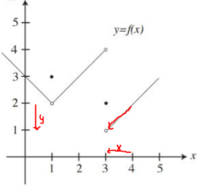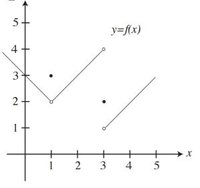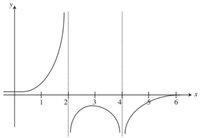I'm trying the Limitation, But I can't seem to interpret the given graphs. What is/are the functions?
- Thread starter tephie159
- Start date
I just need help in interpreting the graphs, particularly graph 2.What is the question?
Dr.Peterson
Elite Member
- Joined
- Nov 12, 2017
- Messages
- 16,822
I suppose you are being asked questions about limits of these functions.I have no idea where I'm suppose to look at to get the function. please explain what I'm seeing.
The key idea that you may be missing is that a function need not have any sort of equation; in this case, the graphs themselves define the functions, and you don't need anything else. Don't be looking for an equation or other information about the function; just look at the graph and use it to answer the question.
For example, f(3) = 2 because there's a dot at (3,2). But the limit of f(x) as x approaches 3 from the right is not 2; looking at the graph, as x decreases toward 3, y decreases toward 1:

That's all you need to do.
I suppose you are being asked questions about limits of these functions.
The key idea that you may be missing is that a function need not have any sort of equation; in this case, the graphs themselves define the functions, and you don't need anything else. Don't be looking for an equation or other information about the function; just look at the graph and use it to answer the question.
For example, f(3) = 2 because there's a dot at (3,2). But the limit of f(x) as x approaches 3 from the right is not 2; looking at the graph, as x decreases toward 3, y decreases toward 1:
View attachment 27831
That's all you need to do.
Dr.Peterson
Elite Member
- Joined
- Nov 12, 2017
- Messages
- 16,822
I just need help in interpreting the graphs, particularly graph 2.
The first thing we need is to see the entire problem, including the specific questions you are asked about the graphs. We can't help without knowing what we are helping with.Sorry I'm still lost, probably since I'm used to extracting an equation. How am I suppose to find the limit with just the intercepts?
Second, please tell us what you have learned most recently, perhaps with an example. We need some idea of what you do understand, in order to explain things in a way that you will follow.
But who said that all you have is intercepts? Were they mentioned in the problem?
pka
Elite Member
- Joined
- Jan 29, 2005
- Messages
- 11,989
I think that the exercise is showing you that the limit is not always about substation.
Consider the first graph of f(x). If is clear that f(1)=4. Now consider limits: x→1limf(x)=2=f(1)
Now look at: x→1−limf(x)=4 & x→1+limf(x)=1 So that x→1limf(x) does not exist.
Consider the first graph of f(x). If is clear that f(1)=4. Now consider limits: x→1limf(x)=2=f(1)
Now look at: x→1−limf(x)=4 & x→1+limf(x)=1 So that x→1limf(x) does not exist.
Dr.Peterson
Elite Member
- Joined
- Nov 12, 2017
- Messages
- 16,822
If you read pka's answer, please be aware that he makes a lot of typos, and don't believe everything you read there! I think he meant "substitution" rather than "substation", and 3, not 4.Sorry I'm still lost, probably since I'm used to extracting an equation. How am I suppose to find the limit with just the intercepts?
But, to restate what I've said before, what we need most from you is to know where you are lost, which includes what you have learned, and what you are able to do with this problem before you get stuck. Do you understand what a limit is? What specific limits is it asking for?
Are you having trouble reading the graph in the first place, so that you don't see that f(1) = 3, because of the dot at (1, 3)? Do you see that f(2) = 3 also, but f(1.5) is about 2.5, f(1.25) is about 2.25, and so on?


